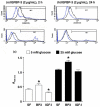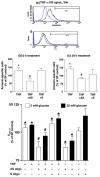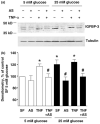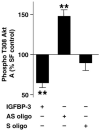Insulin-like growth factor binding protein-3 mediates cytokine-induced mesangial cell apoptosis
- PMID: 15935983
- PMCID: PMC3092586
- DOI: 10.1016/j.ghir.2005.02.008
Insulin-like growth factor binding protein-3 mediates cytokine-induced mesangial cell apoptosis
Abstract
Mesangial cells are critical for glomerular filtration. Mesangial cell dysfunction, the hallmark of diabetic nephropathy, results from disordered mesangial growth induced by cytokines, abnormal hemodynamic influence, and metabolic factors associated with chronic hyperglycemia. Insulin-like growth factors (IGFs) and their high affinity binding proteins (IGFBPs) exert major actions on mesangial cell survival, but their underlying mechanisms remain unclear. In light of emerging IGF-independent roles for IGFBP-3, we investigated IGFBP-3 actions during mesangial cell apoptosis induced by cytokine or high glucose concentration. Quantified by DNA fragmentation ELISA and Annexin V flow cytometry, apoptosis occurred in rat mesangial cells (RMC) exposed to 2 microg/mL IGFBP-3 for 24 h under high ambient or standard glucose. Anti-sense IGFBP-3 oligo at 10 microg/mL significantly inhibited apoptosis induced by 100 ng/mL TNF-alpha, serum-free conditions, or high (25 mM) glucose. Increased IGFBP-3 release associated with high ambient glucose or TNF-alpha was inhibited by pre-treatment with anti-sense oligo. Under serum-free conditions, recombinant human IGFBP-3 blocked Akt phosphorylation at threonine 308 (pThr308), whereas anti-sense oligo treatment was associated with enhanced pThr308 activity. In summary, these data support a novel mechanism for TNF-alpha-induced mesangial cell apoptosis mediated by IGFBP-3 and present regulation of pThr308 activity as a novel mechanism underlying IGFBP-3 action.
Figures






Similar articles
-
Lipoxin A4 inhibits TNF-alpha-induced production of interleukins and proliferation of rat mesangial cells.Kidney Int. 2005 Jul;68(1):35-46. doi: 10.1111/j.1523-1755.2005.00379.x. Kidney Int. 2005. PMID: 15954894
-
Insulin-like growth factor binding protein-3 inhibits the growth of non-small cell lung cancer.Cancer Res. 2002 Jun 15;62(12):3530-7. Cancer Res. 2002. PMID: 12068000
-
Insulin-like growth factor binding protein 5 and apoptosis in mammary epithelial cells.J Cell Sci. 2003 Feb 15;116(Pt 4):675-82. doi: 10.1242/jcs.00263. J Cell Sci. 2003. PMID: 12538768
-
Novel roles of the IGF-IGFBP axis in etiopathophysiology of diabetic nephropathy.Diabetes Res Clin Pract. 2007 May;76(2):177-86. doi: 10.1016/j.diabres.2006.09.012. Epub 2006 Oct 2. Diabetes Res Clin Pract. 2007. PMID: 17011663 Free PMC article. Review.
-
Antiproliferative actions of insulin-like growth factor binding protein (IGFBP)-3 in human breast cancer cells.Prog Growth Factor Res. 1995;6(2-4):503-12. doi: 10.1016/0955-2235(95)00025-9. Prog Growth Factor Res. 1995. PMID: 8817695 Review.
Cited by
-
Low Insulin-Like Growth Factor-1 Level in Obesity Nephropathy: A New Risk Factor?PLoS One. 2016 May 3;11(5):e0154451. doi: 10.1371/journal.pone.0154451. eCollection 2016. PLoS One. 2016. PMID: 27138941 Free PMC article.
-
Proximal tubule cells in blood and urine as potential biomarkers for kidney disease biopsy.PeerJ. 2023 Dec 6;11:e16499. doi: 10.7717/peerj.16499. eCollection 2023. PeerJ. 2023. PMID: 38077419 Free PMC article.
-
Increased tumor necrosis factor-α, cleaved caspase 3 levels and insulin receptor substrate-1 phosphorylation in the β₁-adrenergic receptor knockout mouse.Mol Vis. 2011;17:1822-8. Epub 2011 Jul 6. Mol Vis. 2011. PMID: 21850156 Free PMC article.
-
The insulin-like growth factor system in chronic kidney disease: Pathophysiology and therapeutic opportunities.Kidney Res Clin Pract. 2012 Mar;31(1):26-37. doi: 10.1016/j.krcp.2011.12.005. Epub 2012 Jan 17. Kidney Res Clin Pract. 2012. PMID: 26889406 Free PMC article. Review.
-
Elevated IGFBP3 levels in diabetic tears: a negative regulator of IGF-1 signaling in the corneal epithelium.Ocul Surf. 2012 Apr;10(2):100-7. doi: 10.1016/j.jtos.2012.01.004. Epub 2012 Jan 12. Ocul Surf. 2012. PMID: 22482470 Free PMC article.
References
-
- Flyvbjerg A, Landau D, Domene H, Hernandez L, Gronbaek H, LeRoith D. The role of growth hormone, insulin-like growth factors (IGFs), and IGF-binding proteins in experimental diabetic kidney disease. Metabolism. 1995;44:67–71. - PubMed
-
- Atlas of ESRD in the US. Available from: < http://www.usrds.org/atlas.htm>.
-
- Fornoni A, Lenz O, Striker LJ, Striker GE. Glucose induces clonal selection and reversible dinucleotide repeat expansion in mesangial cells isolated from glomerulosclerosis-prone mice. Diabetes. 2003;52:2594–2602. - PubMed
-
- Tack I, Elliot SJ, Potier M, Rivera A, Striker GE, Striker LJ. Autocrine activation of the IGF-I signaling pathway in mesangial cells isolated from diabetic NOD mice. Diabetes. 2002;51:182–188. - PubMed
Publication types
MeSH terms
Substances
Grants and funding
LinkOut - more resources
Full Text Sources
Molecular Biology Databases
Miscellaneous

